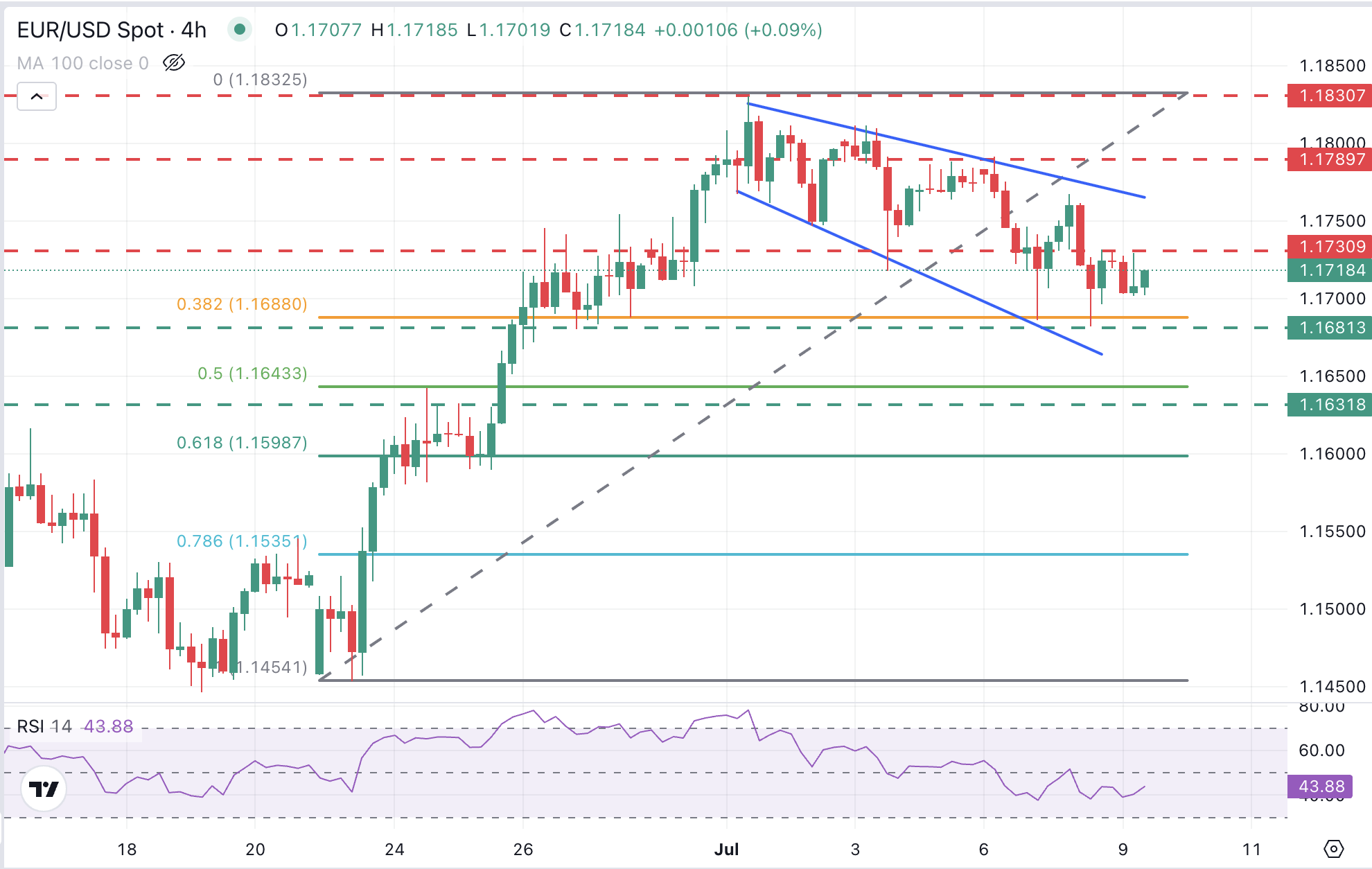- The Euro remains capped below 1.1730 with investors still wary of risk.
- The lack of progress in the Eurozone-US negotiations poses headwinds to a significant Euro recovery.
- The market focus shifts to the FOMC minutes, looking for further guidance for USD crosses.
The EUR/USD pair is posting moderate losses on Wednesday, nearing the bottom of the weekly range, as investors remain wary of risk after US President Donald Trump announced new tariffs on copper and pointed to significant restrictions on pharmaceuticals.
The Euro (EUR) found support at the 1.1700 area on Wednesday’s Asian session after rejection at 1.1770 on the previous day, but upside attempts remain capped below 1.1730 so far. The pair maintains the broader negative trend intact, with price action showing a bearish correction from multi-year highs at 1.1830.
Trump took his trade war to the next stage after announcing 50% tariffs on imports of copper products and threatening a 200% levy on drugs if pharmaceutical firms do not relocate their production to the US within the next 12 months.
These measures come less than 24 hours after the US imposed 25% tariffs on Japan and Korea, the country’s second and third major Asian partners. The deadline for their application was delayed to August 1, and US Government officials left a door open to adjustments if trading partners send their proposals, which contributed to easing the risk-averse reaction to the new tariffs.
In a more domestic scope, the trade negotiations between the Eurozone and the US do not seem to be at their best moment. Eurozone sources continue to express hopes of reaching a deal that will spare them from the 10% baseline levy, but Trump affirmed that he will send a tariff letter to the European Union this week. Not the best news for the Euro.
Euro PRICE Today
The table below shows the percentage change of Euro (EUR) against listed major currencies today. Euro was the strongest against the Canadian Dollar.
| USD | EUR | GBP | JPY | CAD | AUD | NZD | CHF | |
|---|---|---|---|---|---|---|---|---|
| USD | 0.18% | 0.04% | 0.03% | 0.20% | 0.00% | 0.05% | -0.06% | |
| EUR | -0.18% | -0.11% | -0.14% | 0.02% | -0.14% | -0.14% | -0.12% | |
| GBP | -0.04% | 0.11% | 0.02% | 0.14% | -0.10% | -0.08% | -0.10% | |
| JPY | -0.03% | 0.14% | -0.02% | 0.12% | -0.03% | -0.01% | -0.09% | |
| CAD | -0.20% | -0.02% | -0.14% | -0.12% | -0.13% | -0.14% | -0.14% | |
| AUD | -0.01% | 0.14% | 0.10% | 0.03% | 0.13% | 0.00% | 0.02% | |
| NZD | -0.05% | 0.14% | 0.08% | 0.01% | 0.14% | -0.01% | -0.02% | |
| CHF | 0.06% | 0.12% | 0.10% | 0.09% | 0.14% | -0.02% | 0.02% |
The heat map shows percentage changes of major currencies against each other. The base currency is picked from the left column, while the quote currency is picked from the top row. For example, if you pick the Euro from the left column and move along the horizontal line to the US Dollar, the percentage change displayed in the box will represent EUR (base)/USD (quote).
Daily digest market movers: The Euro loses ground with US tariffs in the air
- EUR/USD maintains a broader bearish tone this week. The US Dollar (USD) picks up, buoyed by its safe-haven status amid risk-averse markets and a 5-day rally in US Treasury yields. Investors, on the other hand, remain reluctant to place large Euro bets until the trade relationship between the Eurozone and the US clarifies.
- The fate of the Eurozone-US trade negotiation remains uncertain. Comments from the meeting have been mixed, with Trump saying that the EU was “very nice to us” but also “much worse than China”. From the European side, the Swedish finance minister considered the US proposal “very bad”. EU representatives are still hopeful of reaching a deal, but the US president announced that a tariff letter will be sent to the Eurozone in the next couple of days. The Euro is likely to remain on its back foot in the meantime.
- The Eurozone economic calendar is thin on Wednesday, with only European Central Bank speakers worth mentioning. They are likely to reiterate that the central bank is in a good place to wait for developments in the international trade scenario and their impact on growth and inflation.
- In the US, the highlight is the release of the FOMC Minutes, due later in the day at 18:00 GMT. Federal Reserve Chair Jerome Powell delivered a hawkish message that has been endorsed by the strong US employment figures seen in June. The risk for the US Dollar is on the upside.
- Data from Germany released on Tuesday revealed that the trade surplus increased by EUR 18.4 billion in May, from EUR 15.8 billion in April, against expectations of a slight decline to EUR 15.5 billion. The main reason behind the higher surplus, however, has been a larger-than-expected decline in imports, which points to slower domestic demand.
- In France, the trade deficit widened to EUR 7.76 billion in May from EUR 7.68 billion in April, slightly above the EUR 7.7 billion anticipated by market forecasts.
EUR/USD keeps trading within a corrective channel

EUR/USD recovery attempt was limited right below the descending trendline resistance from July 1 highs, at the 1.1770 area, which keeps the price action within a broadening wedge pattern. This figure reveals an emotional market, often appearing at major tops.
Technical indicators are on bearish territory, with the Relative Strength Index (RSI) wavering below the 50 level on the 4-hour chart, although the support area above 1.1680, where the 38.2% Fibonacci retracement level of the June 24 – July 1 rally meets the July 7 and 8 lows, seems a strong support level.
Below here, the pair might find support at 1.1630 – 1.1645, where previous highs meet the 50% Fibonacci retracement level of the mentioned late June rally.
On the upside, immediate resistance is the intraday high, at 1.1730, ahead of the mentioned trendline and the July 8 high at the 1.1765-1.1770 area.
Fed FAQs
Monetary policy in the US is shaped by the Federal Reserve (Fed). The Fed has two mandates: to achieve price stability and foster full employment. Its primary tool to achieve these goals is by adjusting interest rates.
When prices are rising too quickly and inflation is above the Fed’s 2% target, it raises interest rates, increasing borrowing costs throughout the economy. This results in a stronger US Dollar (USD) as it makes the US a more attractive place for international investors to park their money.
When inflation falls below 2% or the Unemployment Rate is too high, the Fed may lower interest rates to encourage borrowing, which weighs on the Greenback.
The Federal Reserve (Fed) holds eight policy meetings a year, where the Federal Open Market Committee (FOMC) assesses economic conditions and makes monetary policy decisions.
The FOMC is attended by twelve Fed officials – the seven members of the Board of Governors, the president of the Federal Reserve Bank of New York, and four of the remaining eleven regional Reserve Bank presidents, who serve one-year terms on a rotating basis.
In extreme situations, the Federal Reserve may resort to a policy named Quantitative Easing (QE). QE is the process by which the Fed substantially increases the flow of credit in a stuck financial system.
It is a non-standard policy measure used during crises or when inflation is extremely low. It was the Fed’s weapon of choice during the Great Financial Crisis in 2008. It involves the Fed printing more Dollars and using them to buy high grade bonds from financial institutions. QE usually weakens the US Dollar.
Quantitative tightening (QT) is the reverse process of QE, whereby the Federal Reserve stops buying bonds from financial institutions and does not reinvest the principal from the bonds it holds maturing, to purchase new bonds. It is usually positive for the value of the US Dollar.

